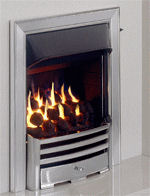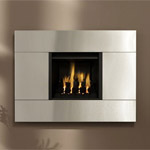So, we know about boilers and systems, what options are available to us with radiators? Radiators vary in sizes and style, some are really for decorative purposes only, so careful consideration must be made when choosing radiators.
Flat panel and convector radiators
Steel pressed flat single panel radiators were the first type of radiators to be fitted in modern homes. These sat quite flat against the wall, and gave radiant heat only. They were generally very large radiators and took up a lot of wall space. They come with crimped or round tops. Stelrad and Myson are two leading manufacturers. Myson still provide radiators to imperial sizes!
These evolved into convector radiators, with fins welded on the back. The benefit of convectors is the movement of air under and over the radiator. You get much more even heat spread in the room. You can also size convector radiators smaller than single panel plain radiators, the convector gives out half as much heat again in some cases.
Double panel double convectors are the largest and most powerful radiators you can get in this style. They do give a lot of heat out, but they also take a lot of space up, protruding off the wall up to 5 inches.
Compact Radiators
There are slight variations to standard radiators, which tend to look a bit more modern. These are called compact radiators. They have grilles on the top, and end panels to hide the convectors inside the radiator. They also tend to sit on the wall flatter, so some people prefer these over any others. They can however collect dust inside which can be difficult to clean.
Towel Rail
These are the modern trend in new bathrooms and toilets nowadays. Some consumers also have them installed in kitchens. They may look nice, but think of them as towel warmers. They do not give much heat out, and care should be taken when choosing them in a new bathroom, You can install electric elements in them that heats them gently in the summer months when the heating is switched off.
Designer Radiators
Another modern trend nowadays is to have the latest looking funky steel creation instead of normal traditional radiators. These may look wonderful, but once again, care must be taken when choosing these as a main heat source. They don't give much heat out, compared to a similar sized radiator. As always, functionality must be sacrificed over form. Column radiators as found in schools and churches are making a bit of a comeback aswell, however they are nowhere near as efficienct as their convector type siblings.
Low Surface Temperature Radiators
Where there are health and safety issues, such as in a care home for the elderly, or a day nursery for young children, there is a special type of radiator available. These radiators are luke warm to touch on the outside, but the inner radiator still gets as hot as a standard radiator. Generally care homes must be kept warmer than your average house, so the radiators are normally on a lot more, and get quite hot. These are a niche product. When you inspect them, they are normally no more than a standard radiator encased in a special metal framework.
Convector Air Heaters
These are not very well known, but fit into another niche in the market for those with limited space.
Say for instance you have a large kitchen with cupboards and worktops everywhere, and you have nowhere to put a radiator. These can be installed under a worktop in the kickspace of the unit. They employ a fan to blow air over a mini heat exchanger - heated by central heating pipes. There is no electric element to heat, so they are very efficient to run. They are also very effective, the heat feels more instant as it's blown into the room. In the summer they can also blow cool air.
You are not limited to fitting these convectors under the kickspace, you can also get a model to fit above a door, called a highline heater, and one to fit on the wall lower down, called a lo-line heater. The only real downside is the cost of them.
Source: http://gasboilerforums.com/









